The most popular chickpea varieties - description and characteristics
Chickpeas (sometimes called nohut, bladderwrack, Turkish, Volga or walnut peas) are a leguminous crop of the legume family, grown commercially in many countries of the Middle East, Central Asia and America. Chickpea seeds have a number of medicinal properties. And its tops, which are high in protein, are used to feed livestock. In the ranking of legumes consumed as food by the population of our planet, it is in third position, right after peas and beans.
Undemandingness to soil quality and the ability to withstand short-term frosts down to -10°C allow Russian plant growers to grow this crop not only in the Stavropol Territory, the North Caucasus and the Krasnodar Territory, but also in the climatic conditions of the middle zone and Western Siberia. In recent years, this valuable food crop, capable of enriching the diet of Russians with high-quality vegetable proteins and fats, is increasingly appearing on the tables of our compatriots.
Varieties of chickpeas by color
Numerous varieties of chickpeas can be divided into several groups, depending on the color of the seeds.
Interesting. According to Rosstat, in 2018, more than 827,000 hectares were allocated for chickpea crops in Russia. Over the year, the area sown with this crop increased by 355,000 hectares, which is 71.6%.
Brown
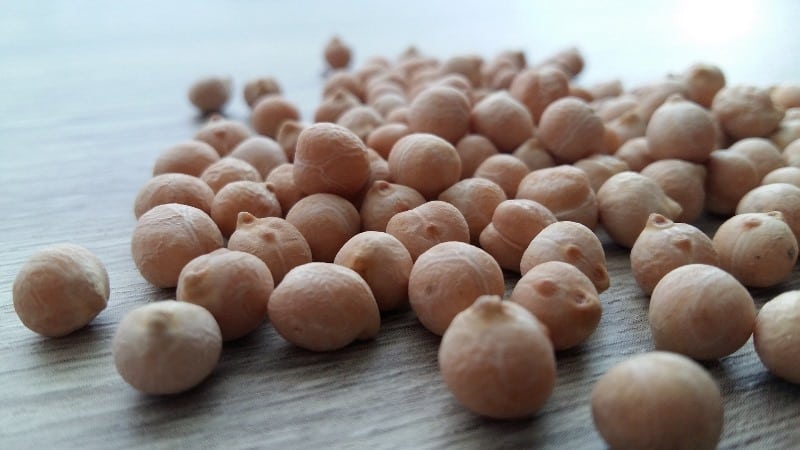
Red-brown peas (seeds), 1-2 pieces each, are located in the fruit-beans of a rounded angular shape.They ripen on compact annual bushes that are not afraid of drought and hot winds, the height of which varies between 45-70 cm.
The growing season ranges from 90 to 100 days. During flowering, red-violet flowers appear on the bushes. The weight of one thousand fruits is 340 g.
The seeds, which have high nutritional value, are often used to produce chickpea flour.
Yellow
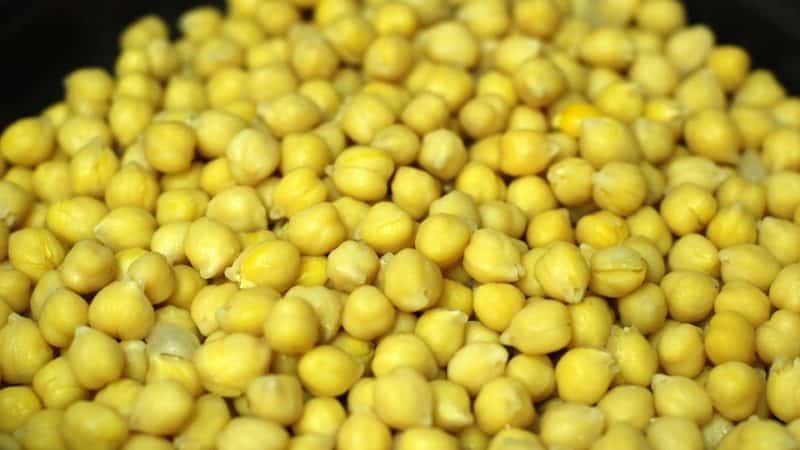
Plants that produce light beige seeds are among the early ripening crops with a short growing season - from 80 to 90 days. On medium-sized, strongly branching bushes, beans containing two seeds appear.
All yellow varieties are characterized by high resistance to lodging, drought, fungal infections such as root rot, as well as to the effects of dry winds.
The seeds are fried, boiled, and used to prepare delicious side dishes.
Red

Compact bushes that produce reddish fruits have a fairly powerful structure. Their botanical characteristics are almost identical to those of other chickpea varieties.
These plants, which rarely suffer from insect pests and diseases, are endowed with the ability to withstand both drought and high soil moisture.
White
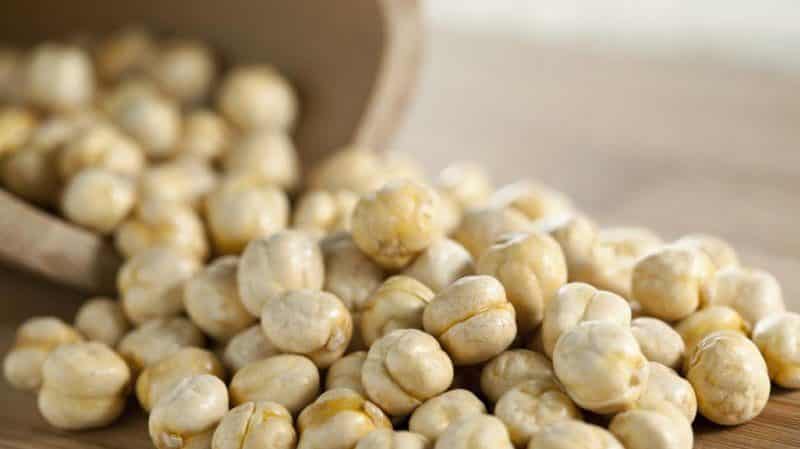
Low – up to 45 cm – bushes are characterized by the presence of powerful shoots. Peduncles are located at a height of at least 20 cm from ground level. This makes it easier to care for the plants, since it relieves the vegetable grower from the need to perform pinching and cutting off the lower shoots in case of high soil moisture. The beans contain 1-2 white seeds.
Plants are little susceptible to pests, diseases and the effects of bad weather conditions.
Black
The botanical characteristics of all varieties of black chickpeas largely coincide with the characteristics of its other varieties.The only radical difference is the dark color of the peas, which, in addition, have a pronounced spicy aroma and a richer taste.
Green
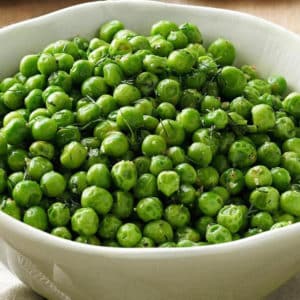
The green color of peas is characteristic of varieties growing in India.
Important. According to the classification based on the appearance of the seeds, chickpeas are divided into two types: desi and kabuli. Kabuli-type varieties bear fruits (beans) covered with a thin, light-colored shell, which is separated from the seed with great difficulty. It is recommended to use them whole when cooking. Desi pea seeds are brown or black in color and have a very thick shell. They are usually used to make flour.
Main types of chickpeas according to ripening speed
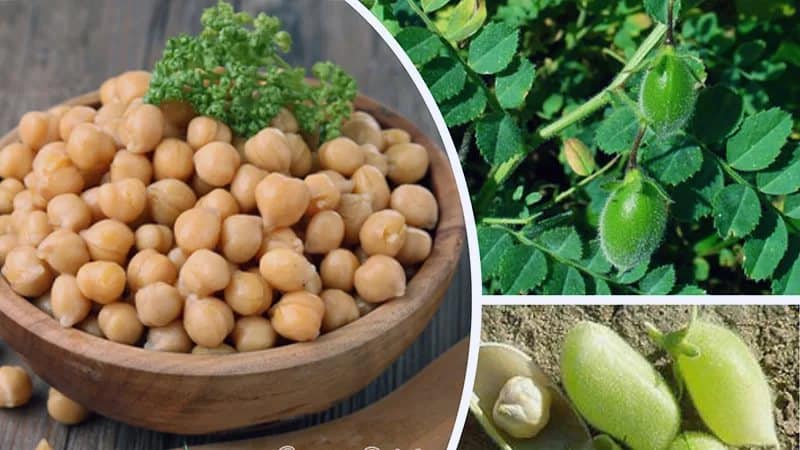
There is a classification that allows you to group chickpea varieties depending on the length of the growing season and seed size.
Varieties of Turkish peas Depending on the growing season, they are divided into:
- early ripening (from 75 to 90 days);
- mid-season (from 90 to 115 days);
- late ripening (from 115 to 140 days).
Early

Among the most popular early ripening varieties is the Galileo variety, obtained by individual selection from the Belazh variety.
Variety characteristics:
- Intensive starting growth - the period from the moment of sowing to the appearance of full shoots is from 7 to 9 days.
- The growing season is 95-98 days.
- High (up to 5 points) resistance to spring frosts, soil and air drought.
- Intensive development of nodules.
- High (0 to 5%) resistance to most fungal and viral diseases (including powdery mildew, rust, septoria, bacteriosis, anthracnose, fusarium, etc.).
- The presence of tall (up to 70 cm) erect bushes.The lower beans are attached to them at a height of 17 to 23 cm from the soil level.
- Resistance to stem lodging. The beans are not subject to falling or cracking.
- Beige color of seeds, having a round or angular shape and weakly expressed ribbing.
- Suitable for growing on any type of soil.
- Suitable for mechanized cleaning. The leaves that fall off when the fruits ripen make threshing much easier.
- The average yield (in the Saratov region) is up to 9.7 c/ha. In the conditions of the Krasnodar Territory, the maximum yield is 22.7 c/ha.
The authors of the Galileo variety recommend it for cultivation in the climatic conditions of the Saratov region.
This is interesting:
What to do and what to do if cucumber leaves wither in a greenhouse: recipes for processing.
Can an allergy to carrots occur, how does it manifest itself and how is it treated?
Mid-season
This group of varieties is the most numerous.
Variety Zoovit
Obtained by the method of individual selection from a mixture of varietal samples from the VIR collection, recommended for cultivation in the conditions of the Saratov region. Author – Aistov Vyacheslav Nikolaevich.
The variety is characterized by:
- Tall (from 38 to 56 cm) semi-erect bushes with large leaves and white flowers.
- Lack of anthocyanin color.
- Beige-colored fruits with medium ribbing and varied (round or angular) shape.
- Average (from 80 to 102 days) duration of the growing season.
- Good drought resistance.
- Average yield up to 16.8 c/ha.
- The presence of large seeds (weight of 100 pieces - from 325 to 405 g), containing up to 24% protein.
- Immunity to diseases - during the period of state tests, not a single case of damage was registered.
Variety Krasnokutsky 36
Cultivated since 1993, it has not lost its popularity among Russian vegetable growers to this day.
Characterized by:
- Significant (up to 60 cm) height of bushes.
- Mid-ripening - the duration of the growing season does not exceed 90 days.
- The location of the lower beans at a level of 25 cm from the ground.
- The presence of not very large (the weight of a thousand pieces is 280-300 g) yellow-pink seeds, which have a round shape and contain from 25 to 28% protein.
- High resistance to fusarium and average immunity to ascochyta blight.
- High drought resistance.
- Stable (at least 20 c/ha) yield in the Volga region. Under favorable weather conditions it can exceed 35 c/ha.
Variety Volzhanin

Originator – breeder Balashov V.V. The variety was bred through individual selection from a hybrid obtained by crossing a large-seeded Syrian sample with the Volgogradsky 10 variety.
Characterized by:
- Tall (up to 70 cm), compact, erect bushes with pubescent stems, oval leaves and white single flowers of medium size.
- The presence of slightly angular beans with a beak-shaped tip, completely devoid of ribbing and colored yellow. Each bean contains from 1 to 2 round, smooth, white seeds (a thousand pieces weigh from 280 to 356 g).
- The average ripening period is from 72 to 101 days.
- Productivity up to 12 c/ha.
- Lower (compared to other varieties) drought resistance.
- Excellent immunity to diseases and pests.
- Good resistance to lodging, cracking of beans and shedding of seeds.
- High taste qualities of fruits.
The use of this promising variety on the territory of the Russian Federation was permitted in 2011.
Classification by fruit size
According to the classification dividing chickpea varieties by seed size, they are:
- small-grained - weight of 1000 seeds - less than 200 g;
- medium grain - weight of 1000 grains - from 200 to 350 g;
- large-seeded - weight of 1000 seeds - more than 350 g.
Average
A characteristic feature of the Rosanna variety is its higher yield than varieties with larger seeds. The fruits are medium, the weight of a thousand pieces ranges from 290 to 310 g.
A variety of Ukrainian selection (Kabuli type), recommended for cultivation in the North Caucasus and the Crimean Peninsula.
Characteristics:
- Semi-standard form of bushes with a height of up to 60 cm.
- Light green color of stems and leaves.
- The presence of single white flowers and large beans with a short spout, the lowest of which are attached at a level of 23-25 cm from ground level.
- Beige colored seeds with an intermediate shape and a wrinkled surface, containing up to 5% oil and 28% protein.
- Average (up to 100 days) ripening period.
- Productivity up to 20 c/ha.
- High drought resistance.
- Relative resistance to fusarium and ascochyta blight.
Large-fruited

A classic example of highly productive large-fruited chickpeas is the Galileo variety. Its main advantage is the high quality of the grains: aligned, large, having a high culinary rating and containing up to 26% protein.
The natural weight (the so-called weight of 1 liter of grain, expressed in grams) of Galileo variety seeds is 835-852 g. The weight of 1000 grains is from 360 to 420 g.
This is interesting:
Comparing chickpeas and peas: what are the differences and what are the similarities.
What is the difference between chickpeas and peas? - let's deal with these beans.
Conclusion
High yield, undemanding soil type, resistance to adverse weather conditions, excellent taste of fruits that benefit the body - these are the main factors underlying the growing popularity of this crop.